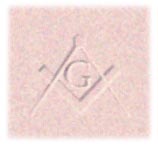
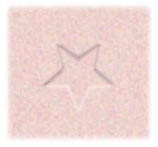


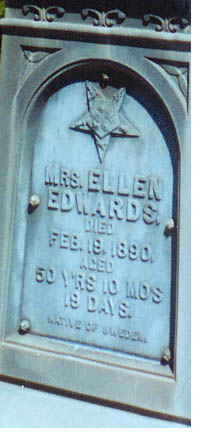 Do not expect to see Masonic burials in Catholic or Baptist cemeteries. Other cemeteries may have some Masonic burials and the Masonic symbols may appear on both headstones and tombs. These monuments may have just one symbol, usually, the Square and Compass, or on rare ocassions, may contain a number of Masonic symbols. Perhaps the most common symbol we see today is the Square and Compass with the letter “G” in the center. The “G” is said to represent “Geometry” or “God.” Seen on the gravemarkers of wives of Masons is the Eastern Star, an inverted pentagram. Notice the example of an Eastern Star symbol (to the left) on a white bronze marker (zinc) from the Pine Grove Cemetery, Nevada City, California.
Do not expect to see Masonic burials in Catholic or Baptist cemeteries. Other cemeteries may have some Masonic burials and the Masonic symbols may appear on both headstones and tombs. These monuments may have just one symbol, usually, the Square and Compass, or on rare ocassions, may contain a number of Masonic symbols. Perhaps the most common symbol we see today is the Square and Compass with the letter “G” in the center. The “G” is said to represent “Geometry” or “God.” Seen on the gravemarkers of wives of Masons is the Eastern Star, an inverted pentagram. Notice the example of an Eastern Star symbol (to the left) on a white bronze marker (zinc) from the Pine Grove Cemetery, Nevada City, California.
Another symbol that we might encounter is the “All-seeing Eye,” or as some call it, the “All-seeing Eye of God.” The All-seeing Eye is also found on non-Masonic monuments. It represents the Great Architect of the Universe. The first image below of the All-seeing Eye is from our dollar bill and it is claimed by some to be Masonic - but not by most Masons. The Eye of God enclosed in a triangle represents the Holy Trinity. We see that the All-seeing Eye on a pyramid also symbolizes the true stone mason’s work. The second image is from the white bronze marker as found on a Masonic monument. The third, from Greenwood Cemetery, Columbia, Maury County Tennessee, is not from a Masonic marker. Incidentally, the three links, one of which is broken, is not the Odd Fellows symbol. Their Three Link Fraternity is unbroken, it stands for Friendship, Love and Truth. (Greenwood photo: tom kunesh)
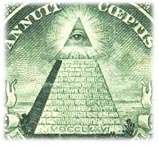
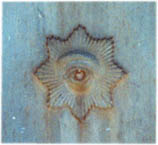
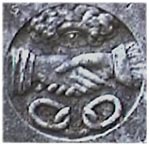
Also see:
32nd° Scottish Rite “Doublehead” Eagle; the most recognized symbol of the Scottish Rite Masons. Our example shows the eagle on a cross potent clutching a draped sword, displaying a shield with a square and compass, the scales of justice, and an inverted pyramid (equilateral triangle) with the number 32 (from a sarcophogus, ca 1900)
Anchor with Square and Compass
The ladder of three rounds, leading to the moon and ’seven stars,’ or the Pleiades
Senior Warden’s Plumb
The Free and Accepted Masons is a secret organization, however their symbols are well known. While we work at getting illustrations of the symbols which may appear on burial monuments, we have included an excerpt from the “History of Nevada, 1881” by Thompson & West, p. 234. The many symbols mentioned there are tattoos on a body of a man found drowned.
MASONRY ON THE PACIFIC COAST
With the argonauts, who came in search of the golden treasures of California in 1849, were parties who, previous to leaving their homes at the East, had formed themselves into companies for either mining or commercial purposes, or both, as well as for mutual protection. Several of these organizations were comprised mainly of Masons, and had, previous to setting out upon their journey to the far West, applied to the lodges where they were made for permits, or dispensations, to open lodges and “work” when opportunity offered. These dispensations eventually became the nuclei around which some of the first Masonic Lodges of California formed.
The following incident will show that, although no lodges were organized until the spring of 1850, the brethren of the mystic tie of the Pacific Coast, nevertheless forgot not their charitable duties, even among the allurements attendant upon those flush, golden times of the earlier days:
The first Masonic funeral that ever took place in California occurred in the year 1849, and was performed over the body of a brother found drowned in the bay of San Francisco. On the body of the deceased was found a silver mark of a Mark Master, upon which were the initials of his name. A little further investigation revealed to the beholders the most singular exhibition of Masonic emblems that were ever drawn by the ingenuity of man upon the human skin. There is nothing in the history or tradition of Masonry equal to it. Beautifully dotted on his left arm, in red and blue, which time could not efface, appeared all the emblems of Entered Apprentice. There were the Holy Bible, the Square, and the Compass, the twenty-four inch gauge, and the common gavel. There were also the Mosaic pavement, representing the ground floor of King Solomon’s Temple, the identical tassel which surrounds it, and the blazing star in the center. On his right arm, artistically executed as the others, were emblems pertaining to the Fellow Craft, the plumb, the Square, and the level. There were also the five columns, representing the five Orders of Architecture -- the Tuscan, Doric, Ionic, Corinthian, and Composite.
In removing his garments from his body, the trowel presented itself, with all the tools of operative Masonry, besides all the emblems pertaining to the degree of a Master Mason. Conspicuously on his breast were the Lights of Masonry. Over his heart was the Pot of Incense. On the other parts of his body were the bee-hive, the book of constitutions, guarded by the Tyler’s Sword; the Sword pointing to a naked heart; the all-seeing eye; the anchor and ark; the hour-glass; the forty-seventh problem of Euclid; the sun, moon, stars, and comet; the three steps, emblematically of youth, manhood and old age. Admirably executed was the weeping virgin, reclining on a broken column, upon which lay the book of the constitutions. In her left hand she held the Pot of Incense-emblem of a pure heart -- and in her uplifted hand a sprig of acacia -- the emblem of the immortality of the Soul. Immediately, beneath her stood winged Time, with his scythe by his side-which cuts the brittle thread of life-and the hour-glass at his feet-which is ever reminding, us that our lives are withering away. The withered and attenuated fingers of the destroyer were delicately placed amid the long and gracefully flowing ringlets of the disconsolate woman. Thus were the striking emblems of mortality and immortality beautifully blended in one pictorial representation.
It was a spectacle such as Masons never saw before, and in all probability such as the fraternity will never witness again. A large concourse attend the burial; the impressive service of the craft was read; the sprig of acacia was dropped into the grave by the hands of men from all quarters of the globe; the grand honors were given, and the stranger was entombed in the last resting-place allotted to mankind. His name was never known.



